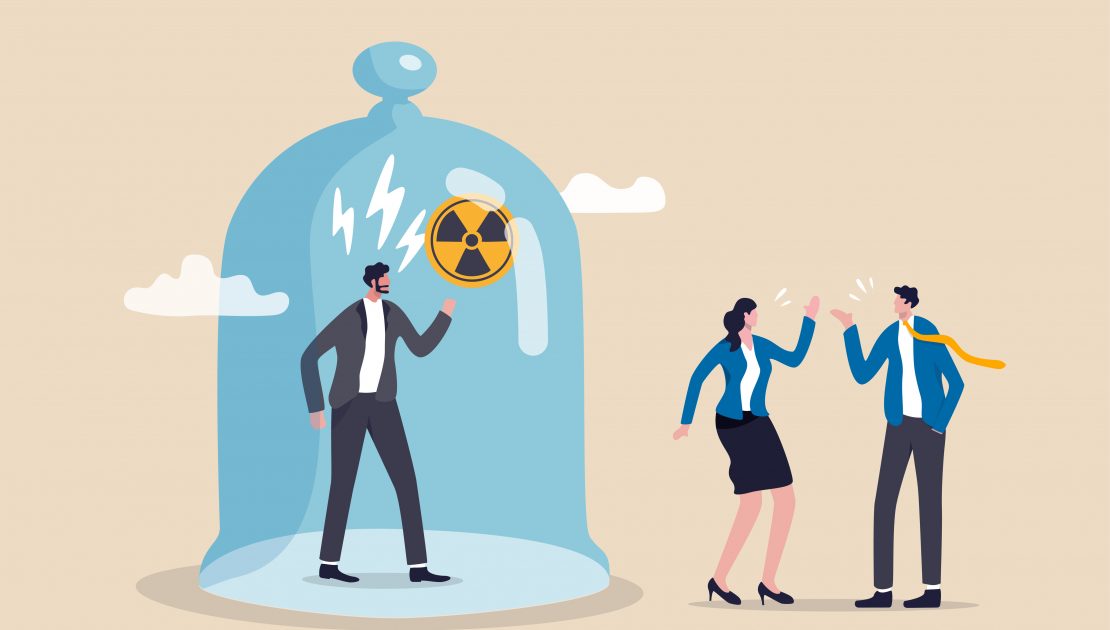
- June 16, 2023
- Ela Stilwell
- Podcast
- No Comments
Toxicity is often a slow build. The presence of a toxic team member often results in the individual becoming the topic of more and more conversations, essentially robbing the energy from the project.
Rod and Dale discuss four steps for tackling toxic people: recognition of the toxic behaviour, digging deep, confrontation, and following through.
Our blog posts are a condensed version of our podcast! Listen to the episode linked above to hear Rod and Dale take you through this content.
Tackling Employee Toxicity
1. Recognize Toxic Behaviour
When there are toxic individuals in a project, one of the worst things a project manager can do is ignore the behaviour and pretend it doesn’t exist.
Patrick Lencioni talks about the impact of ignoring negative behaviour in the law of thirds. According to this law, one-third of any given team will be made up of hard workers focused on getting the job done and dedicated to the project. Then you have the middle third, who are neutral: they show up and do the job. This middle third can be influenced by the last third, who are the complainers, the whiners and the people who could conceivably, at some point, become toxic.
Lencioni’s point is simple: whichever group you listen to and give your energy to will influence the neutral third. If you focus on those who are delivering, those hard workers, you will get more out of them. The challenge is you can’t just ignore the toxic person. In Rod’s experience, they don’t just go away, they kind of entrench themselves, and then they start infecting that neutral group who will recognize that this behaviour seems acceptable.
But if we don’t address that toxic element, one way or another, great people end up leaving. In a project management context, this can be viewed through the risk management lens: we need to identify the risk and then figure out how to mitigate, eliminate or manage the risk. A toxic person is a risk – one you can’t ignore.
There are many self-serving reasons to ignore toxic behaviour, including the perception that the person is needed to get through the project.
But that doesn’t mean you need to allow that person to harm others, take away team members’ voices, or diminish others’ abilities or effectiveness.
2. Dig Deep
When you have a toxic employee who is causing harm to the people around them, Rod encourages digging deep and getting some background.
At this stage, we see that not all toxicity is the same. We’re not just talking about the problematic employee who may be grumpy, complain a little, or not participate. We’re talking about the person who’s really bringing a level of toxicity to the team.
By digging deep, you may understand the root of the toxicity, which will help you address the issue. Rod shares that in his experience, we often don’t know what makes that toxic person tick. This may be a traumatic experience, a bone to pick that no one talks about or an issue with an individual. Digging deep can happen in a one-on-one interview or reconnaissance talking with people who have worked with the individual before.
There is an important balance to be struck here, as keeping the toxic behaviour at the centre of the conversation often perpetuates the negative impact of the initial behaviour. In addition, the goal here is not to gossip; having private conversations with individuals must occur with the vocalized goal of confronting the toxic person.
3. Confrontation: Go Into the Danger
Project leaders need to confront the person exhibiting toxic behaviour, to have the tough conversation. It’s the leader’s job to get the most out of everyone on the team, and that can’t happen when there’s a drain on energy and morale. In their conversation, Dale and Rod go so far as to call it a leader’s ethical obligation to call out toxic behaviour. Simply put, a leader needs to determine if the person is aware of their behaviour and its impact on the project.
A leader needs to organize a meeting with the individual and identify how much they know about the impact of their behaviour.
Are they aware of the behaviour, or is it a blind spot?
In some cases, they may be aware of the impact of their behaviour. Rod’s found that often individuals have something gnawing at them, which needs to be addressed as it gets in the way of them behaving in a normal, accepted fashion. Others may only become alive to the impact when they start thinking about it, and that’s an uncomfortable realization to have.
In digging deep, you may discover that this individual doesn’t even know they are perceived as toxic. The Johari Window model identifies that individuals have a blind spot concerning themselves and that there are things others perceive about us that we aren’t aware of. This blind spot can result in us justifying our behaviour because we believe that we’re right or that what we stand for is the most important.
When you walk into that danger, you may also be alerting the individual to a blind spot. If this is the case, present some of the issues observed. In Rod’s experience, for the most part, people can be reasoned with, and it’s a leader’s job to help them understand how their behaviour is actually impacting the people around them.
Are they aware of the consequences of their behaviour and its impact on the team’s ability to deliver the project? Ask them to share the effect they think their behaviour is having on the project, to declare what’s happening rather than telling them.
If left unaddressed, toxic behaviour can worsen, the person consuming more space and degrading more performance. The rest of the team is then left to suffer the consequences.
4. Follow Through
So you’ve identified, investigated and called out the toxic behaviour. Now what? Ultimately, we need to weigh the effect whatever decision made will have on the project, specifically seeking out actions that will have the least negative impact.
After your conversation, the individual may change their behaviour, and that’s great! But that’s not always the case.
Some people simply will not change, and those are the people whom we really need to take action with. First, very clearly document as much as possible so you have a proper paper trail – both the good and the bad. In Rod’s experience, it’s easy to forget the little situations or incidences or blow some up in your mind as the months go by. Still, you also forget some of the positive contributions of that individual, resulting in tunnel vision, where all you can see is the toxicity.
If the person refuses to change, you need to escalate it. In Rod’s experience, there is really nobody indispensable on a project – a myth that can get in the way of making that final call. Looking at this once again from the lens of risk management, the best solution may be to remove the risk entirely. Sometimes, people cannot change in certain work environments or while working with certain people. On a practical level, you may not be able to make such a decision, but you can raise the risk to someone else – someone you report to or the toxic individual reports to.
That said, there are often necessary individuals (based on skill set, technical ability or resources) that make alternative arrangements the best-case scenario. The person may remain on the team but not as a member of the core project, or are dealt with at arm’s length as a supplier of x information or y resource. That may be all the mitigating action that can be taken.
In many instances, we can let toxic behaviour persist for too long. Any part of a system that is weak is, at some level, going to affect the rest of the system. Without diminishing the value people bring, this is no different for toxic people on a team. Eventually, even those great performers will give less of themselves or be less productive because of that toxicity.
Obstacles in Tackling Toxic People
Project managers are in a difficult position, as they often don’t have a lot of control over who the team members are. This removes some of the options at your disposal, as you may be unable to remove them from the project if their behaviour doesn’t change. When we lack authority, we can still lead through influence. Even without authority, it doesn’t change the fact that we need to confront inappropriate behaviour whenever we see it.
Best Practice
Call out and stop toxic behaviour early and whenever you see it, whether you’re in a meeting or interacting one-on-one.
